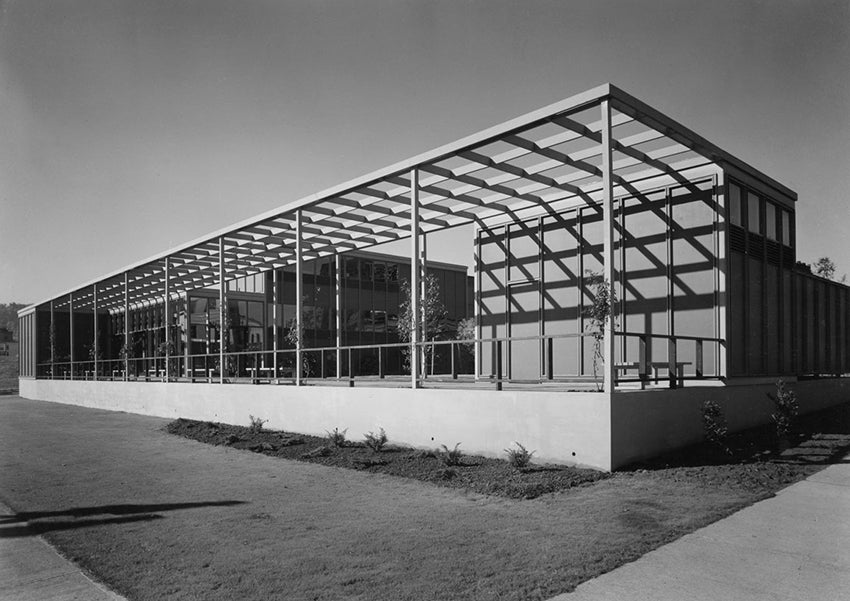A major retrospective of Oregon architect John Yeon opens at the Portland Art Museum May 13 and runs through September 3.

Above: Aubrey Watzek House, 1937, exterior.
Quest for Beauty: The Architecture, Landscapes, and Collections of John Yeon surveys two dozen projects and buildings designed between 1927 and the mid-’50s, including a 1934 scheme for Timberline Lodge; Yeon’s inventive plywood houses of the late ’30s; and the 1950 Shaw House, which elegantly anticipates Postmodernism. The exhibition was developed with the University of Oregon’s John Yeon Center for Architecture and the Landscape.
The installation features original models and drawings that invite a greater understanding of Yeon’s careful siting of buildings and his cutting-edge construction and sustainable design techniques. Images by a trio of the midcentury’s greatest architectural photographers—Ezra Stoller, Maynard Parker, and Roger Sturtevant—will also be showcased.
Few architects have influenced so many facets of a region as John Yeon (1910-1994). Yeon is most widely remembered as an architect, in particular for a series of innovative houses including the Aubrey Watzek House, a 1937 modernist masterpiece and Portland's only National Historic Landmark residence.
Yeon had equal vision and influence as a planner, conservationist, historic preservationist, urban activist, and connoisseur of elegance and craft. Largely self-taught and self-employed, Yeon designed distinctive buildings, shaped precedent-stretching gardens, and fought to preserve some of the Northwest’s most treasured vistas, including the Columbia River Gorge, the Oregon Coast, and Olympic National Park. The exhibition features a video that records the changing seasons at The Shire, a stunning 78-acre preserve in the Columbia Gorge that Yeon saved from development.
Yeon also amassed a personal collection of Asian and European decorative arts. The exhibition highlights art, decorative arts, and historic materials lent by Richard Louis Brown, who founded the Yeon Center in 1995 with his gift of the Watzek House to the University of Oregon. The John Yeon Center acts as steward for the Watzek House, The Shire, and the Cottrell House, a 1950 modernist home near Forest Park.

Above: Aubrey Watzek House, 1937, interior.
“John Yeon and the High Stakes of Regionalism in the 1930s,” an opening lecture by architecture scholar Barry Bergdoll, will take place at 2 p.m. May 14 at the Portland Art Museum.
Quest for Beauty is accompanied by two books published by the Yeon Center with Monfried Editions—John Yeon: Architecture and John Yeon: Landscape. The latter volume features photographs by Susan Seubert and essays by landscape historian and UO emeritus professor Kenneth Helphand, founding director of Friends of the Columbia Gorge Bowen Blair, and Yeon Center director Randy Gragg, who also curated the exhibition.
Events related to the exhibition include tours and lectures. Tours of Yeon properties are scheduled from May to September.
In this lecture series Gragg will discuss Yeon’s buildings and landscapes at the UO in Eugene at 5:30 p.m. April 18 in 177 Lawrence Hall. Art history Professor Keith Eggener will discuss Modern architecture and Yeon’s influence in establishing a regional style of architecture; he’ll speak at the UO in Eugene at 5:45 p.m. May 10 at 177 Lawrence Hall.
Visit the Portland Art Museum website for additional information about Yeon and the exhibition.

Above: Portrait of John Yeon, 1977, by John Hinchliff, John Yeon Archive.

Above: The Lynn and Vera Vietor House, Indianola, California, 1941, designed by John Yeon.

Above: Yeon’s 1948 Portland Visitors Center, also known as the Rose Building, combined principles of the International style with influences of the Northwest Regional style, which Yeon pioneered.

Above: The Shire occupies a 75-acre waterfront site in the heart of the Columbia River Gorge directly across from Multnomah Falls.
